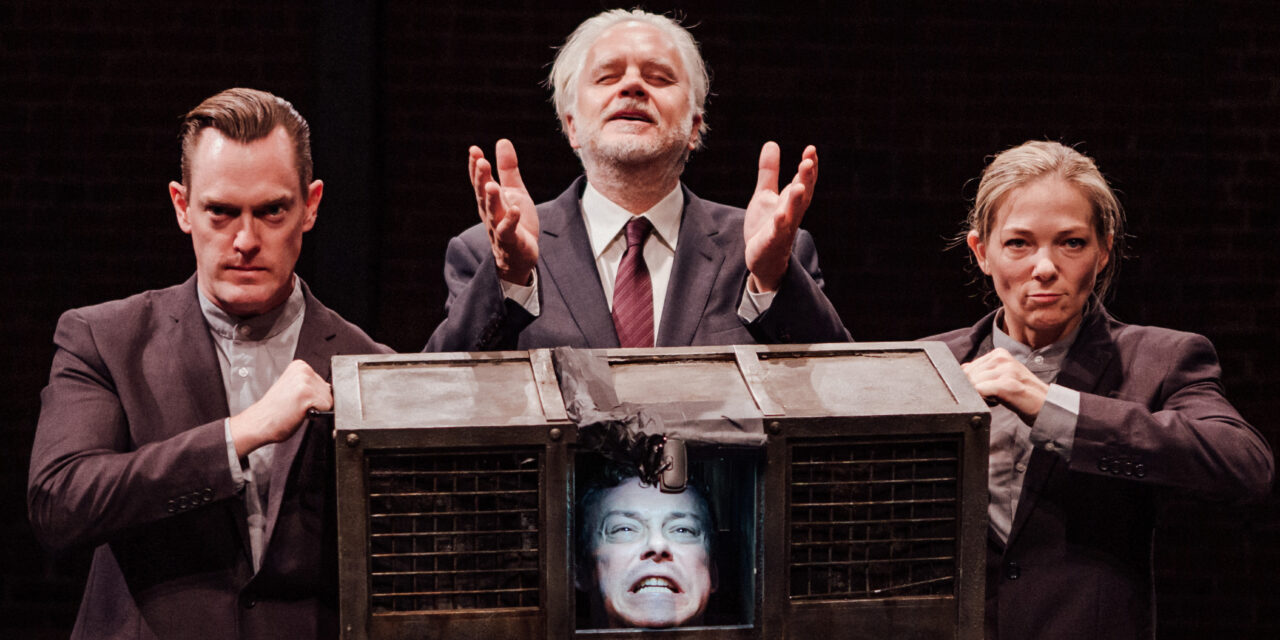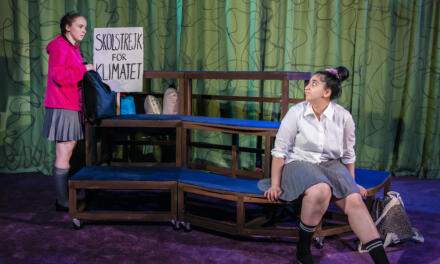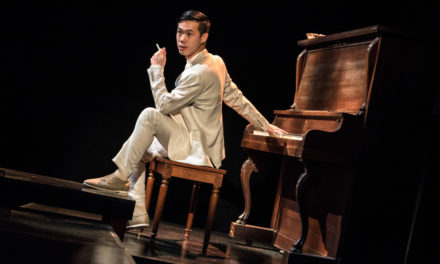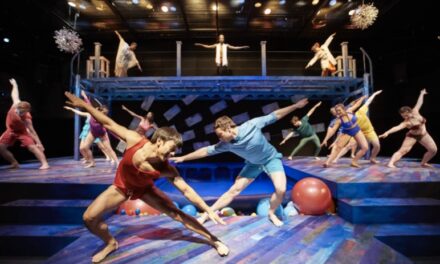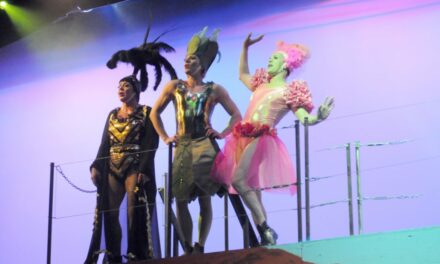“He who controls the present controls the past, and he who controls the past controls the future.” – Winston Smith
Situated in Culver City and founded in 1981, The Actors’ Gang is known for creating an experimental home for new work as well as a creative space where classics are interpreted via a relevant and provocative lens – and their production of Michael Gene Sullivan’s adaptation of George Orwell’s 1984 feels about as relevant as you can get right now.
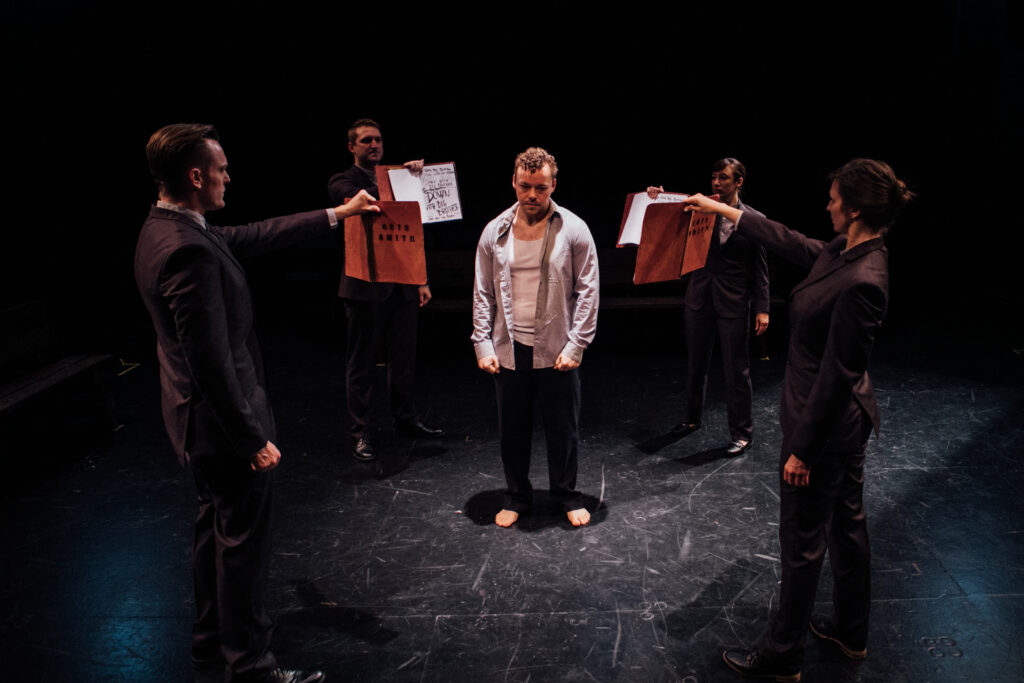
Bob Turton, Thomas Szymanski, Will Thomas McFadden, Lee Margaret Hanson and Hannah Chodos in 1984. Photo by Ashley Randall.
The company’s Artistic Director, Tim Robbins directs a cast of six tremendous actors in the square with the audience seated in rows along the walls of the playing space with enough room for action to unfold around as well as in front of them. As you enter, four stools are set in aisles between the onstage seating, two screens (one faces the regular seats, one faces the stage) feature closeup footage of an eye scanning the room as if in hopes of trying to catch one of us mid-thoughtcrime. There are small light panels that hang from the grid above the stools… and nothing else. The lights go out after the pre-show announcement welcomes us as fellow citizens using text appropriate language to tell us where the exits are, etc. Lights come up on Winston and Party Members No. 1, No. 2, No. 3 and No. 4. Each wears a suit and holds a file in their hands with Winston’s name on the front (6079 Smith) while Winston wears clothing that hints he’s been there for a while. There’s one costume change, and in the second act, three new props are introduced. It’s as stark as it comes and there is nowhere to hide – not for the actors and not for the audience – and that’s absolutely perfect.
Granted, it is also uncomfortable and upsetting at times but that’s the beauty of the choice. We are so used to hiding behind devices, blocking out the world with wireless earbuds, pretending we don’t see each other that our being placed in this environment is a startling shift. Seated on the stage, you cannot help but catch the eye of a fellow audience member across from you, and even if you are quick to look away, you will still see the look on their face, the tear in their eye, the impact of the work that is likely mirrored in your own expression. It took a bit of conscious effort not to default to the ‘arms across chest’ semi-defensive social position because the level of intimacy was that palpable (but I encourage you to uncross them when you go see this work). Even if you are not lucky enough to be seated on stage, you are then lucky enough to be seated in the house where you get to not only watch the performance but also the mass reactions to the performance, and those can be just as illuminating. There’s a raw energy in the space right from the top and the actors are primed to tap into it and use every last ounce to propel themselves into this ultimately heartbreaking, terrifying warning of a story.
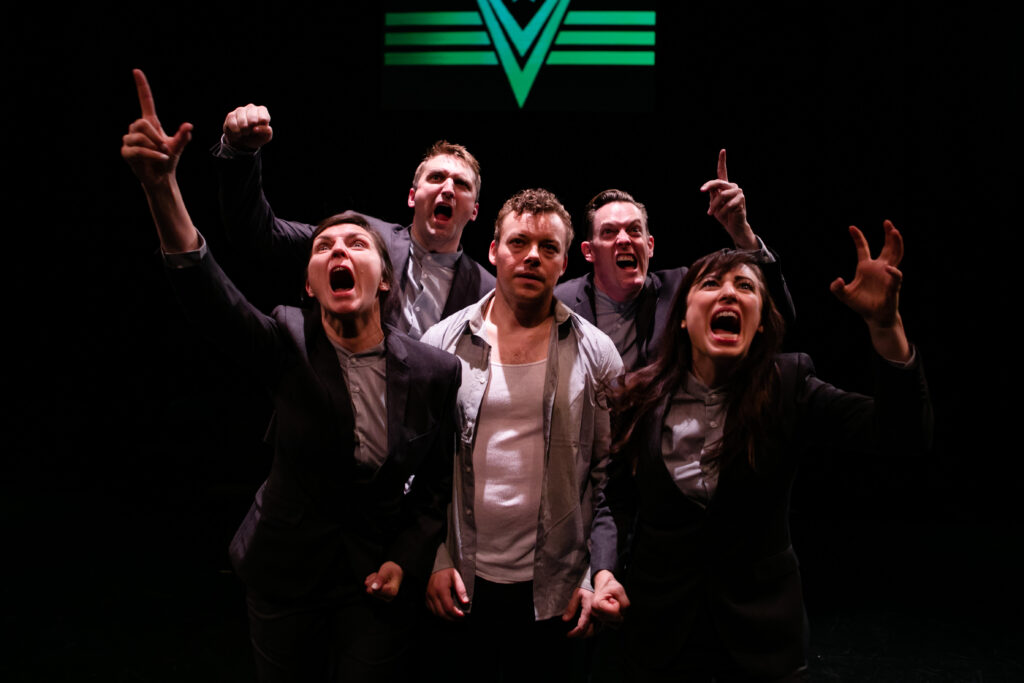
Hannah Chodos, Will Thomas McFadden, Tom Szymanski, Bob Turton and Lee Margaret Hanson in 1984. Photo by Ashley Randall.
Will Thomas McFadden is Winston and we meet him in the middle of what looks like a very long interrogation. He responds to a voice who asks him questions and reminds him that he must “be precise” as Party Member No. 1 (Tom Szymanski, who also plays ‘enemy of the state’ Goldstein), Party Member No. 2 (Lee Margaret Hanson (who also plays Julia – and Mrs. Parsons at this performance) Party Member No. 3 (Bob Turton, who also plays Mr. Charrington and Mr. Parsons) and Party Member No. 4 (Ethan Corn, who also plays Syme – he went on for Hannah Chodos, who was unable to perform that night) surround him, harangue him, use his diary against him and generally do everything they can to push him to a breaking point. They also play out scenes from his diary, with Szymanski taking on the role of Winston and Hanson as Julia. McFadden may tell his story at times, but even when his is the voice we hear, Hanson’s focus is on Party Member No. 1 and their connection builds over time. There were a few moments where she made eye contact with McFadden instead, but that happens later on in the second half of the play when it is clear that Winston’s story has more of an effect on the Party Members than anyone might have considered possible.
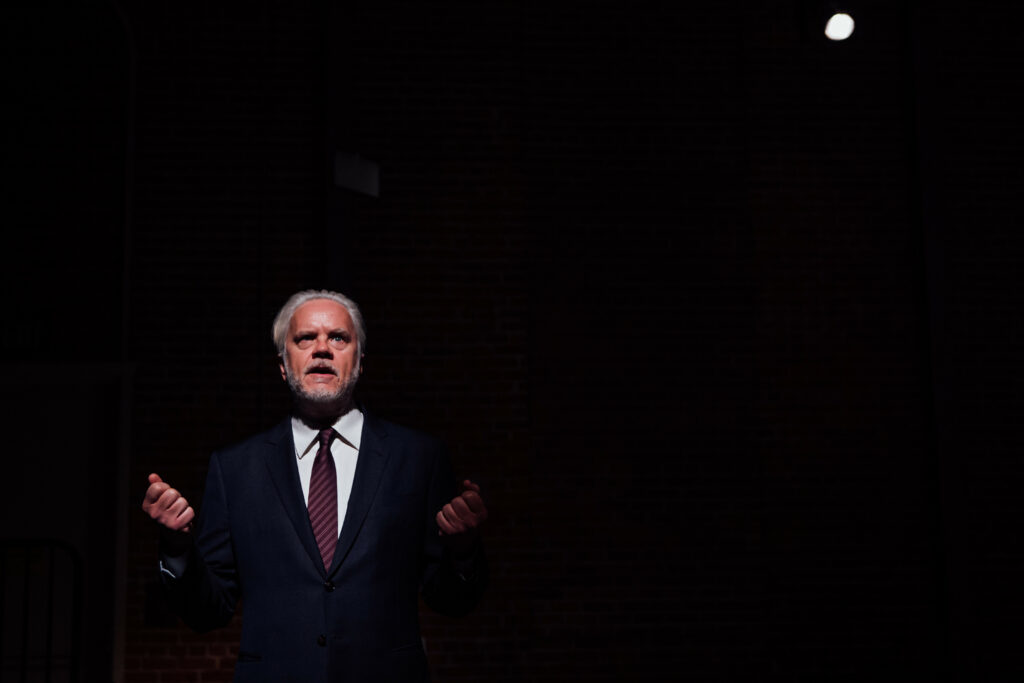
Tim Robbins in 1984. Photo by Ashley Randall.
If you don’t know the story, honestly, you should read the book. George Orwell wrote it in 1949 and he essentially described a world we are perilously close to living in (so close, we may already be there and not know it yet). There’s a film version out there, there have to be audiobooks or better yet, visit The Actors’ Gang in Culver City but no matter how you do it, this production underscores just how important Orwell’s dystopian vision is right now. Winston and Julia live in Oceania where Big Brother watches and listens in on everyone all the time via telescreens. They defy Big Brother by falling in love, spending as much time as they can in a room above an antique shop where there is no telescreen. Winston is tempted into reading a book and in this world, books are almost as dangerous as love. They are betrayed, and then betrayed again, but for those of you who don’t know how, I’m only going to say that as the character O’Brien, Tim Robbins makes his first stage appearance since The Guys in 2005 (and it is a thrill to see him in this role) the depth of the betrayal is slowly revealed and it is a punch to the gut. He is an imposing figure with a calculated way of looking at the world that will sound and feel very familiar if you pay any attention to politics or the news. He morphs truth into lies and lies into truth with the ease of a man who is certain nothing can challenge his word as the state manufactures conflicts and shortages to propel its citizens to hate the ‘other’. Robbins does it with a smile that screams ‘POWER’ and makes you like him even as he creeps you out.
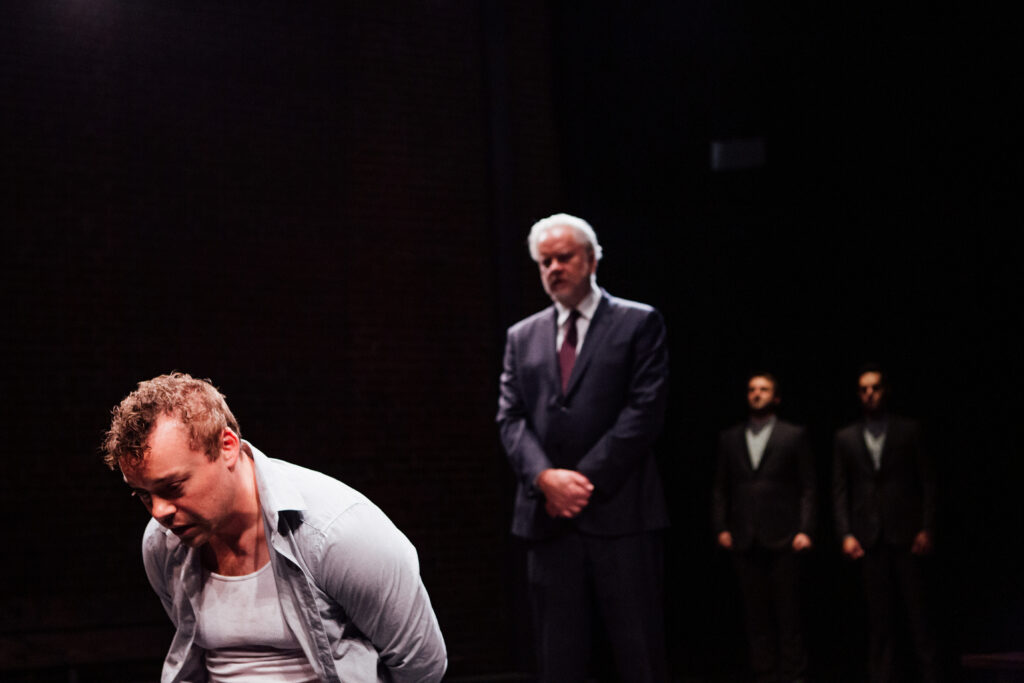
Will Thomas McFadden and Tim Robbins in 1984. Photo by Ashley Randall.
O’Brien doesn’t need to work too hard to keep the Party Members on his side, even as he goes about breaking Winston down. It isn’t just the idea of Big Brother that lends him his authority – the (tele)screens back him up. Once the play starts, the all-seeing eye is replaced with a feed from a camera situated above Winston’s head. The image is blown out so details are hard to spot at times and once O’Brien appears and circles Winston like a shark, he seems to know where the frame ends and keeps just outside the eye of that lens in a way that makes you think about police interrogations or other such footage in our day. If you know where the cameras are, that’s another way you can manipulate the truth. Intermittently in both acts of the play, the screens burst to life with footage created to incite an emotional response from the Party Members. It’s hard to miss the similarities these ‘breaking news’ flashes have to a certain 24-hour news service and for extra credit, make sure you look closely at the flag that tops each series of clips and note the corporate logos that have taken the place of stars on the American flag. Each of these bits of ‘news’ raises the stakes for the audience, if not the actors, for they could be ripped from the headlines and that’s not a comforting thing to consider.
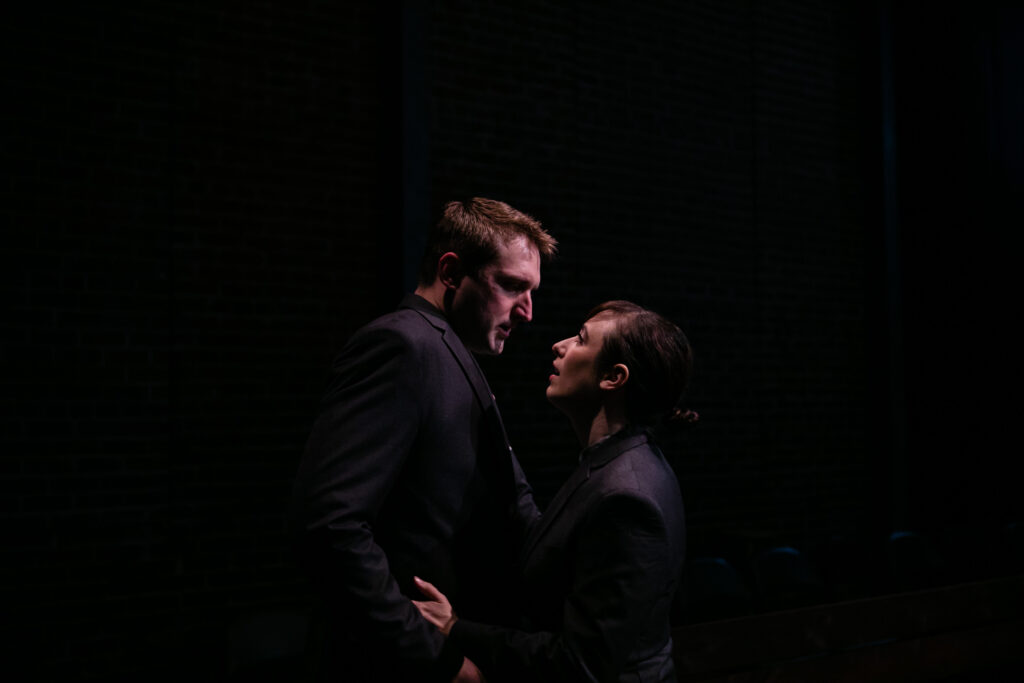
Tom Szymanski and Lee Margaret Hanson in 1984. Photo by Ashley Randall.
Between the bursts of ‘news’ and the attempts to break Winston, the story of his love affair with Julia unfolds and though Party Members No. 1 and No. 2 start out just as full of hate and disgust as their fellow interrogators, over time their participation in the story as Winston and Julia has such an obvious emotional impact on Szymanski and Hanson that we fall in love along with them and it is a beautiful and painful thing to watch. They fall prey to the very thing they start out hating and it visibly softens both of them until they start casting longing looks across the space to each other the very way we imagine Winston and Julia might have done. Though they can say nothing, the loss of the connection they have found is like a knife to the heart, and it is clear in the final moments of the play that one of the two is no longer the same and will face the consequences of that just as Winston does in Room 101 (again, if you don’t know, it’s a dreadful place to end up). Throughout the physical work in the show is intricate, specific and strong and it was an honor to be able to sit with this company and watch them ride this emotional roller coaster that makes love actually seem as dangerous as Big Brother thinks it is. This is strong work that gives us a lot to think about, and more than a few things to be fearful of.
The Actors’ Gang first presented Orwell’s 1984 in 2006 and since then they have taken it to over 40 US states as well as to countries like Greece, Italy, Spain, Australian, China and Mexico (I saw the 2006 production as an audience member and I haven’t been able to forget it). Lighting Design by Bosco Flanagan. Production Design by Cihan Sahin. Sound Design by David Robbins. Tess Vidal is the Costume Designer and Assistant Director. Set Design by Mit Snibbor. Set Construction by Chris Bisbano. The Technical Director is Josh Keh. Danielle Powell is the Stage Manager. Thomas Roche is the Assistant Stage Manager. Illustration by Gerard Dubois. Video Editing by Paul Hogan. Directed by Tim Robbins.
For more information, please see the company’s website: https://theactorsgang.com/
This post was written by the author in their personal capacity.The opinions expressed in this article are the author’s own and do not reflect the view of The Theatre Times, their staff or collaborators.
This post was written by Christine Deitner.
The views expressed here belong to the author and do not necessarily reflect our views and opinions.

